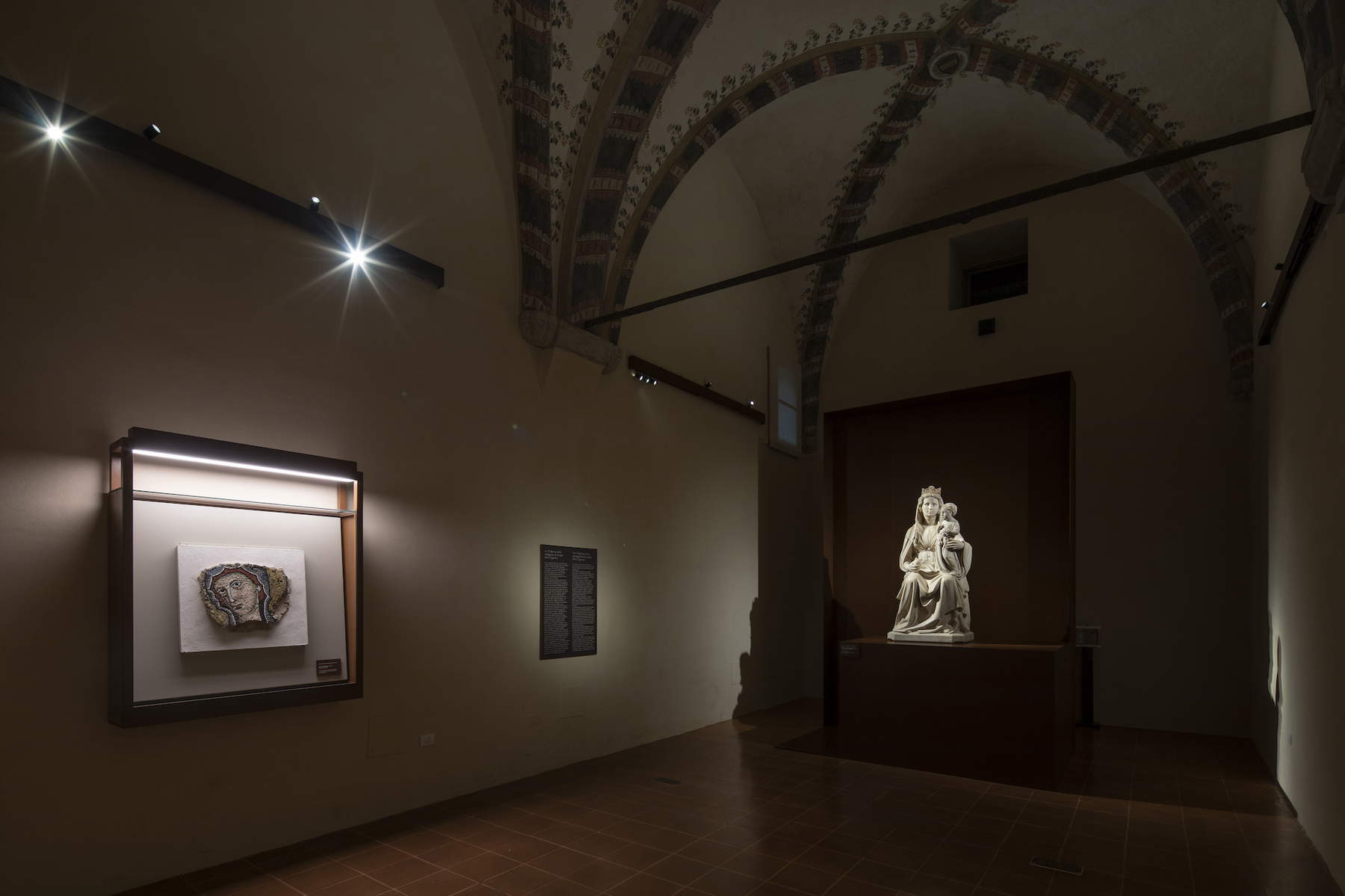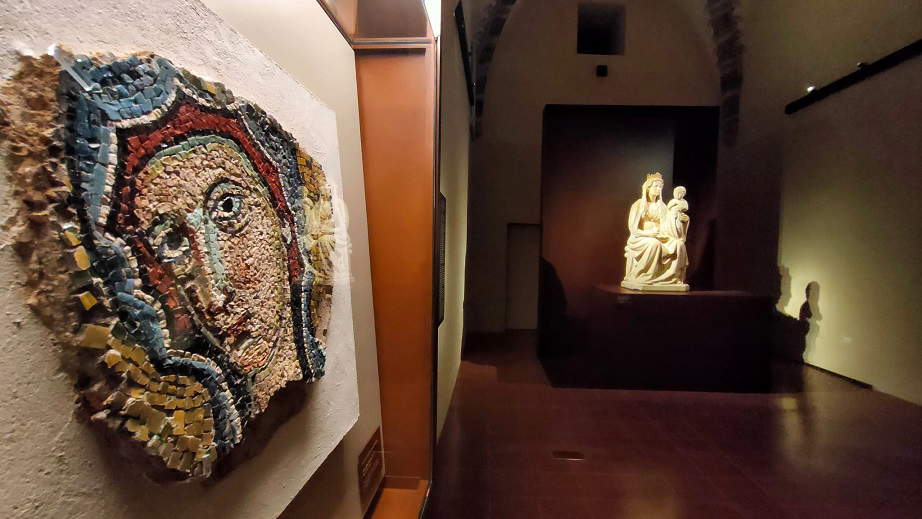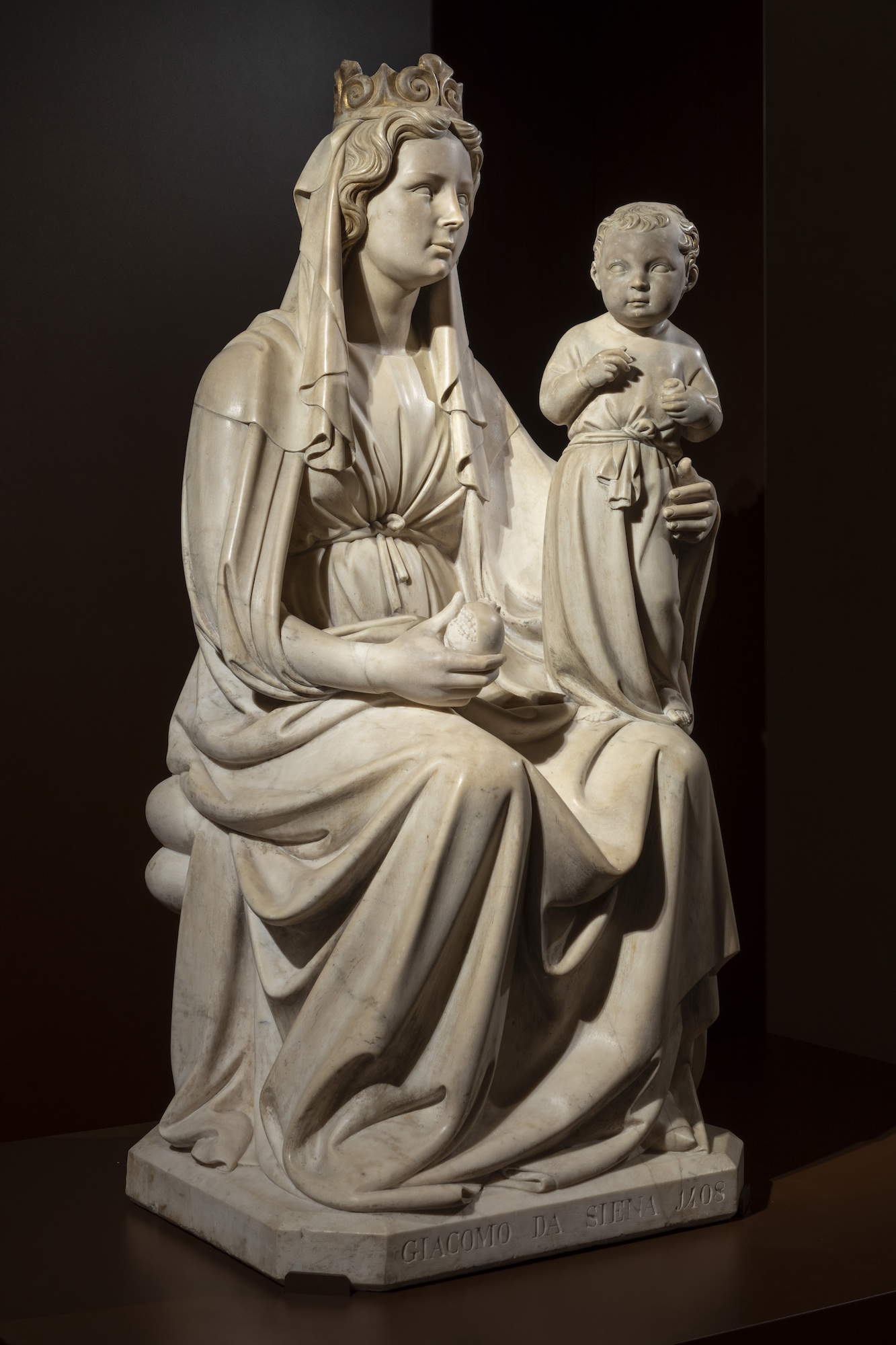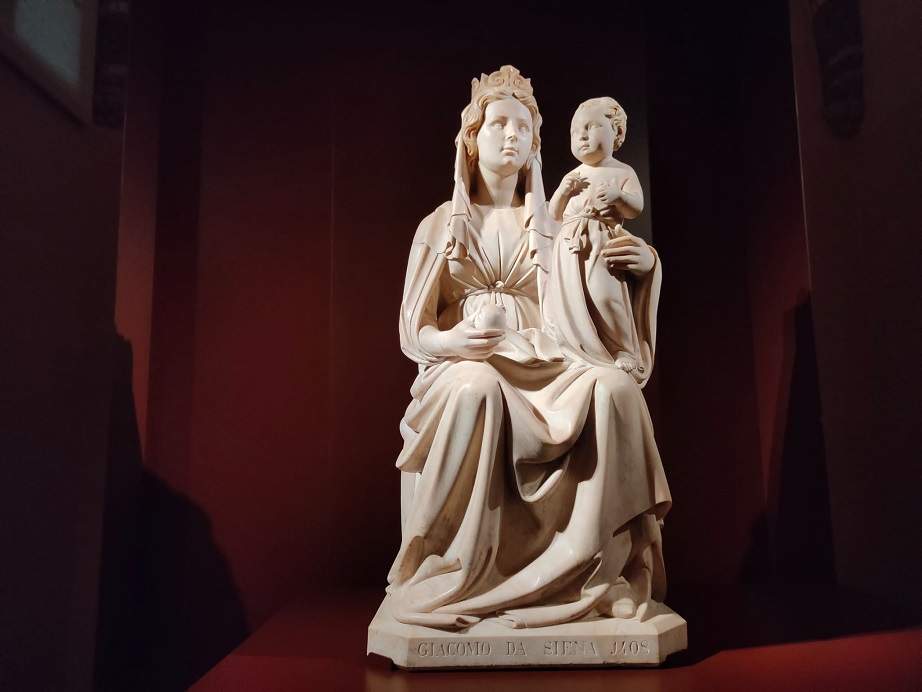Ferrara, new setting for Madonna of the Pomegranate, masterpiece by Jacopo della Quercia
The Madonna of the Pomegranate, a masterpiece by Jacopo della Quercia (Siena, c. 1374 - 1438) preserved in the Ferrara Cathedral Museum, finds a new layout and a new location in the former sacristy of the church of San Romano: it is with the inauguration of the new layout that the Museum will be reopened on February 8, with hours 9:30 a.m. to 1 p.m. and 3 p.m. to 6 p.m. Monday through Friday.
For the Ferrara museum, this is an important milestone: 20 years after its move to the Via San Romano location and after an initial exhibition renovation in 2018, in fact, the museum reopens by partially changing its forms and offering visitors the opportunity to admire the new display of the Madonna of the Pomegranate. The Carrara marble statue is now dedicated a different museum “narrative” than in the past: in fact, the work is now in a room of its own, placed in a cleverly designed space, in dialogue with the fragment of mosaic of the Venetian school with the head of the Virgin (from around 1135) once on the archway of the Cathedral and with Cavalier d’Arpino ’s Holy Family (currently under restoration, but which will return in early March), as if to emphasize their character as foreign works compared to the works created by the artists of theFerrara Workshop.
The lighting is also new: a perceptual upgrading has been carried out to bring out the miraculous balance between plasticism and softness achieved by an artist whom Giorgio Vasari considered to be among the first to have competed with nature, to the point of giving “animo e speranza agl’altri di poter, in un certo modo, pareggiare la natura.” Among these others was even Michelangelo, who would take his first steps as a sculptor precisely by being inspired by Jacopo della Quercia.
 |
| The new display of Jacopo della Quercia’s Madonna of the Pomegranate at the Cathedral Museum (courtesy of the Cathedral Museum: ph. Le Immagini sas) |
 |
| The new display of Jacopo della Quercia’s Madonna of the Pomegranate at the Cathedral Museum (courtesy of the Cathedral Museum: ph. Le Immagini sas) |
The Madonna of the Pomegranate is indeed considered a fundamental work for the fate of 15th-century Italian sculpture, executed by Jacopo della Quercia shortly before the famous Funeral Monument of Ilaria del Carretto (1406-1408) in Lucca. Welded to the sculptor and his guarantor Tommasino da Baiso in June 1408, the work was commissioned in September 1403 by the executors of the will of Virgilio Silvestri, chamberlain of Marquis Nicolò III d’Este, and placed three years later in the family chapel along the left flank of the ancient Duomo. From its appearance, this grandiose block of marble weighing about fourteen quintals became a landmark in the artistic and religious life of the Este Cathedral. Evidence of this can be found in fifteenth-century documents relating to the liturgical paraphernalia with which the work was adorned during pastoral visits, or in the affectionate definitions coined during the eighteenth century of Madonna Bianca or Madonna del Pane, the latter arising from the erroneous identification of the Scroll of the Law that the Child holds in his little hand with the characteristic shape of Ferrara bread.
Around the Madonna of the Pomegranate, the Cathedral Museum has redefined part of its spaces, placing, for example, the precious reliquaries in the chancel, in a more intimate location appropriate to their original function, and its image, with a restyling of the educational apparatus, signage and the Museum’s logo itself. The work was promoted by the Management Board of the Cathedral Museum, financed and directed by the Monumental Heritage Service of the Municipality of Ferrara, benefiting from a grant from the Emilia-Romagna Region under Regional Law 18/2000.
 |
| Jacopo della Quercia, Madonna of the Pomegranate (1403-06; Ferrara, Cathedral Museum). Courtesy of the Cathedral Museum: ph. Le Immagini sas) |
 |
| Jacopo della Quercia, Madonna of the Pomegranate, detail (1403-06; Ferrara, Cathedral Museum). Courtesy of the Cathedral Museum: ph. Le Immagini sas) |
 |
| Jacopo della Quercia, Madonna of the Pomegranate |
“In working on this project, we felt ourselves in the care and emotion of the ancient laborers who in 1403 transported the 14-quintal block of marble from the quarries of Carrara to the territory of Ferrara,” says curator Giovanni Sassu. In contrast, Archbishop Monsignor Gian Carlo Perego said the new display is “an important piece to enhance the extraordinary heritage of the city and church of Ferrara.” Perego recalled how the Madonna of the Pomegranate is a “motherhood that reminds us of the value of protecting life,” just days before the anniversary of the day dedicated precisely to life. With Perego, Monsignor Ivano Casaroli, president of the Cathedral Chapter, remarked how “there is no fruitful present without memory. To investigate the works in our museum is to explore the history of the Cathedral from its founding in 1135 until the latest interventions during the 1900s.”
“Jacopo della Quercia’s work is a living sculpture,” explained Ferrara Arte President Vittorio Sgarbi. “This Madonna welcomes visitors like the Mother, combining religious values with an extraordinary human dimension.” Sgarbi also drew attention to the golden highlights visible in the Madonna and Child’s hair, which emerged following the latest restoration. Regional councillor Mauro Felicori, on the other hand, emphasized the value of reopenings: “On Monday this museum reopens. It opens a glimmer, at least in the yellow and weekday areas, after an inauspicious year. News that we welcome with joy, passion, work knowing that it must only be the beginning. Museums are not a danger.”
Deputy Mayor Nicola Lodi stressed the Administration’s “constant commitment” to all aspects of the life of our beautiful Ferrara,“ recalling that the ”works were financed by the Municipality’s monumental heritage service, benefiting from a contribution from the Emilia-Romagna Region."
“That of public works is a sector that also has a cultural and philological imprint, as is clearly evident here,” stressed Councillor Andrea Maggi, who was present, along with Lodi, with the municipal staff (including managers Natascia Frasson and Ethel Guidi), recalling that “The pomegranate is the fruit of rebirth. Hence the hope that from this image a rebirth for Ferrara can begin.”
 |
| Ferrara, new setting for Madonna of the Pomegranate, masterpiece by Jacopo della Quercia |
Warning: the translation into English of the original Italian article was created using automatic tools. We undertake to review all articles, but we do not guarantee the total absence of inaccuracies in the translation due to the program. You can find the original by clicking on the ITA button. If you find any mistake,please contact us.



























